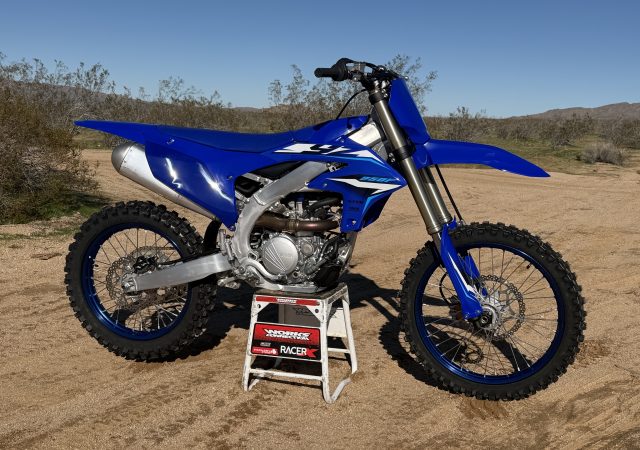
For this edition of Classic Steel, we are going to take a look back at Suzuki’s all-new RM125 for 2001.
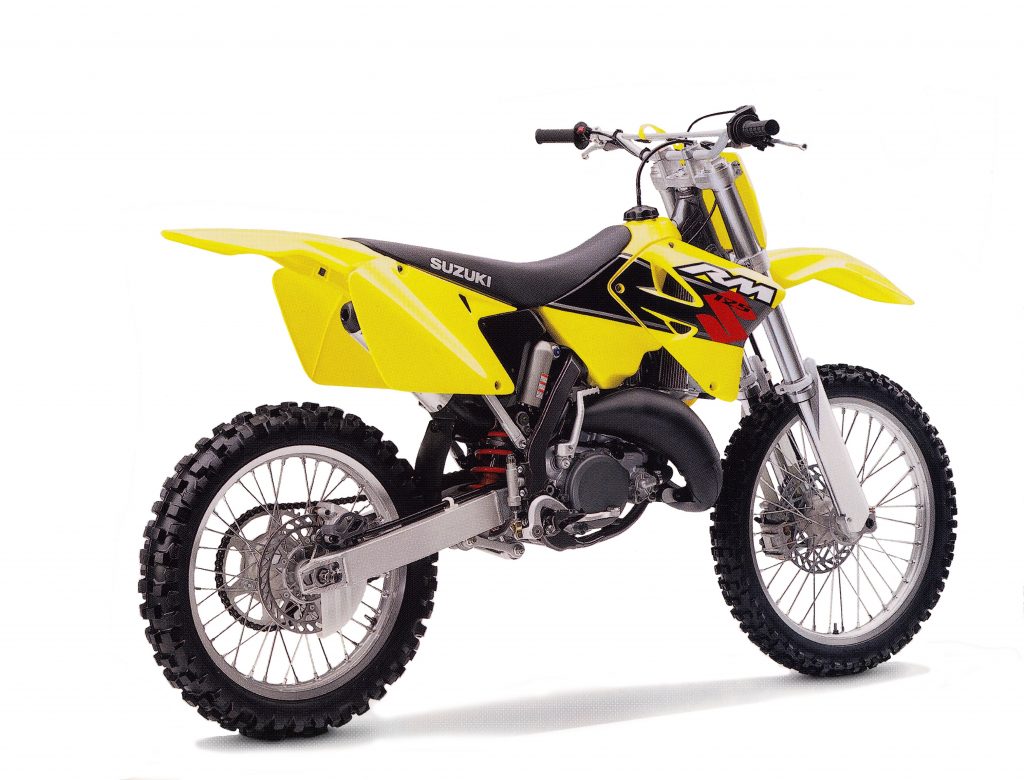 Suzuki’s 125 National Motocross title-winning 125 sported a whole new look for 2001. Photo credit: Suzuki
Suzuki’s 125 National Motocross title-winning 125 sported a whole new look for 2001. Photo credit: Suzuki
The late 1990s were a tough time to be riding anything but blue in the 125 class. Starting in 1996, Yamaha’s YZ125 had enjoyed a virtual stranglehold on the tiddler division. For most riders, the Yamaha’s mixture of broad (for a 125) power, good suspension, and do-it-all handling was a tough combination to beat.
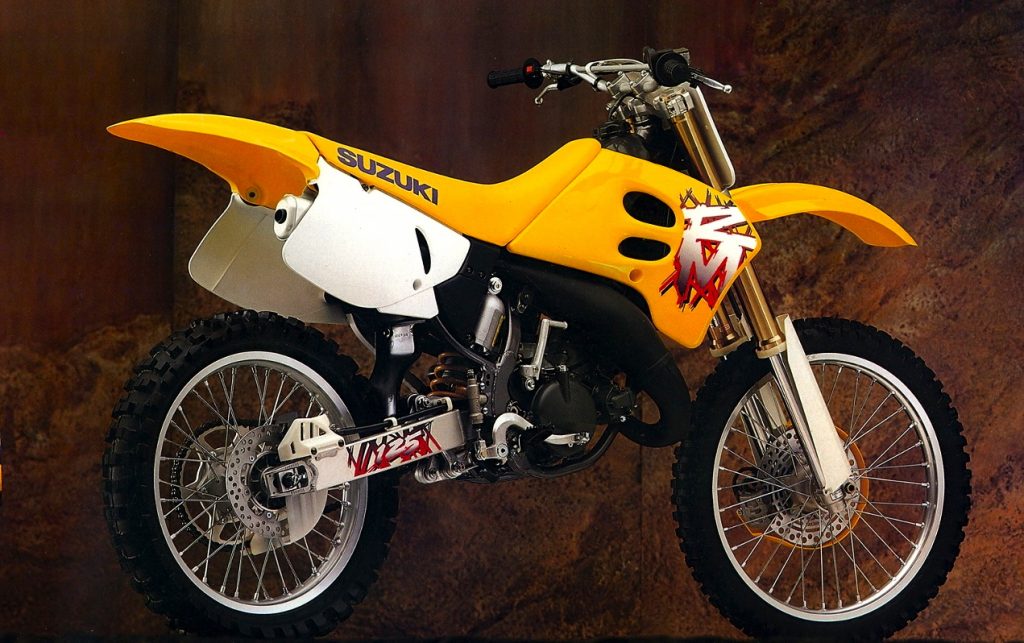 In the early to mid-nineties, the RM was the bike to beat in the 125 class. For 2001, Suzuki looked to reclaim that lost glory. Credit: Suzuki
In the early to mid-nineties, the RM was the bike to beat in the 125 class. For 2001, Suzuki looked to reclaim that lost glory. Credit: Suzuki
Before Yamaha’s ascension in ’96, it was Suzuki that had enjoyed the mantle of best 125 in the land. These early-to-mid-nineties RMs had offered razor-sharp handling, punchy motors, and great forks. They were not as fast on top as Honda’s shrieking CR125R, but they were easier to ride and better all-around machines.
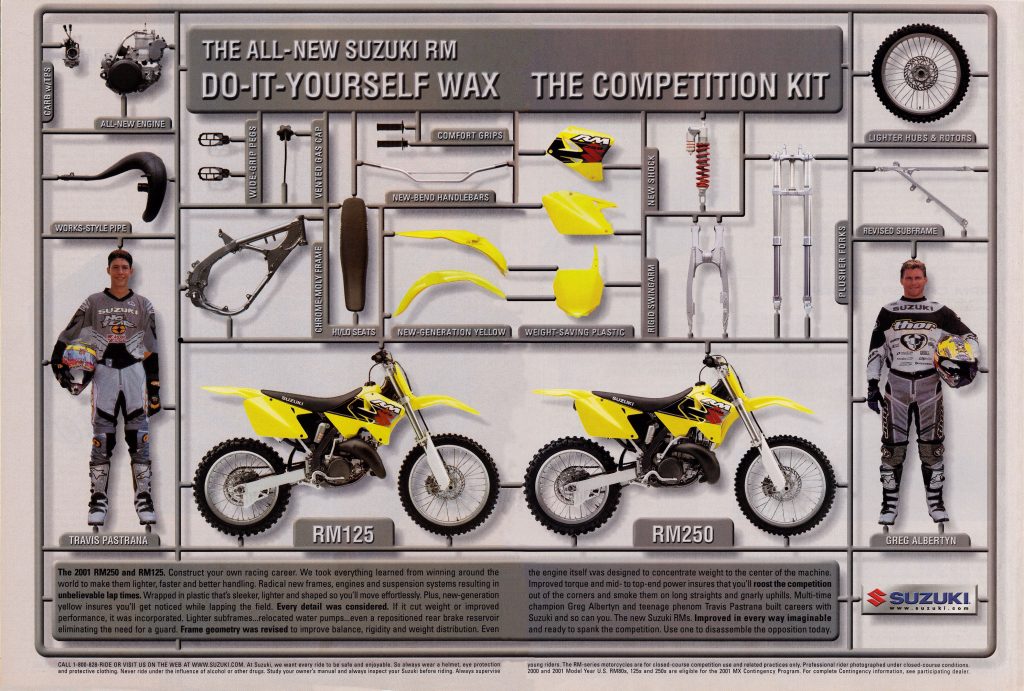 Any of us who grew up building model kits will certainly appreciate this clever ad for the all-new RMs. Photo Credit: Suzuki
Any of us who grew up building model kits will certainly appreciate this clever ad for the all-new RMs. Photo Credit: Suzuki
In 1996, Suzuki had introduced an all-new RM125 they hoped would continue their run at the top of the 125 division. This ‘96 machine featured sexy new bodywork, a redesigned engine, and a switch back to conventional forks for the first time since 1989. While the bike handled great and the forks worked phenomenally, the motor package was just not up to running with the most powerful machines in the class. Its low-to-mid burst motor was fun, but not particularly fast and a handicap against the brawny Yamaha and blazing-fast Honda.
 An all-new cylinder and reshaped power valve looked to boost top-end power for 2001. Photo Credit: Suzuki
An all-new cylinder and reshaped power valve looked to boost top-end power for 2001. Photo Credit: Suzuki
Over the next few years, Suzuki refined its RM125 package, but it never quite lived up to the success of the 1993-1995 design. In 1999, they moved away from their excellent conventional Showa forks to a more standard, but less effective inverted alternative. That year they also bolted on a massive 38mm carburetor to pump up the top-end pull. This gave the ’99 and 2000 RM125s lots of revs, but not a ton of effective power. Both bikes could be revved to the moon, but neither one offered much in the way of torque. For really fast guys this was not an issue, but for most mere mortals the broad power of the YZ was better.
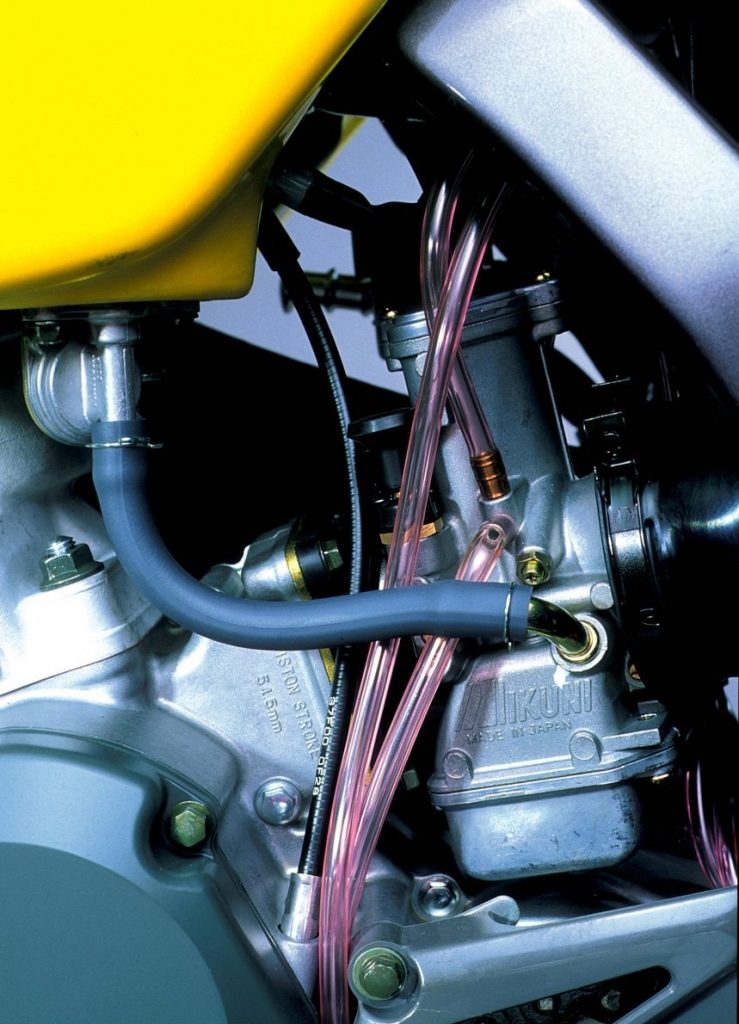 A massive 38mm (the same size carburetor employed by Honda’s CR500R) Mikuni promised beaucoup revs in 2001. Photo Credit: Motocross Action
A massive 38mm (the same size carburetor employed by Honda’s CR500R) Mikuni promised beaucoup revs in 2001. Photo Credit: Motocross Action
For 2001, Suzuki knew they were going to have to swing for the fences if they were going to unseat the perennial champion of the 125 class. To do this, their engineers dialed up a complete redesign of their 125 package. Literally, everything from the diameter of the clutch cable to the shape of the front fender was scrutinized in an effort to produce a lighter, faster, and more competitive racer.
 By moving the water pump back outside the cases Suzuki was able to shrink the motor, lower the weight, and simplify maintenance for 2001. Photo Credit: Motocross Action
By moving the water pump back outside the cases Suzuki was able to shrink the motor, lower the weight, and simplify maintenance for 2001. Photo Credit: Motocross Action
First up on the chassis side was an all-new frame that looked to both improve handling and reduce weight. The new frame continued to use chromoly steel for its construction, but the new design saved weight by reducing the width of the frame spars and the main downtube by 10mm. Suzuki also replaced the round tubing of the lower cradle with stamped square tubing to increase strength and further save weight. Both the swingarm pivot area and rear subframe were also reengineered to reduce flex and save a few precious ounces. Overall geometry was tighter for 2001, with a reduction in rake and trail of 1.25 degrees and 10mm. On the scale, all these changes to the frame added up to a savings of 1.28 pounds over the 2000.
 The new RM chassis was much better for taller riders in 2001 but even that wasn’t enough for Big Bird types like Travis Pastrana who needed taller seat foam to accommodate his lanky frame. Photo Credit: Dirt Rider
The new RM chassis was much better for taller riders in 2001 but even that wasn’t enough for Big Bird types like Travis Pastrana who needed taller seat foam to accommodate his lanky frame. Photo Credit: Dirt Rider
The diet program was not limited to the frame either. A new fork retained the inverted design of 2000 but reduced weight by shaving down the diameter of the outer tubes by 2mm. A new shock was also installed that saved nearly a pound by simplifying the compression circuit and installing a new spring. New wheels for 2001 were lighter and in the case of the front, slightly narrower (20mm) overall. Both discs were also lighter for 2001 with larger slots in the front and a reduction of 0.5mm of width in the rear. The rear master cylinder and brake pedal were also redesigned to save weight and the front disc guard was deleted entirely. Even the plastic was shaved down in thickness for 2001 to save even more weight. In addition to being thinner, the new bodywork was formed out of a much brighter shade of yellow Suzuki dubbed “Champion Yellow.”
 In order to increase intake velocity Suzuki reduced the tilt of the ’01 cylinder by three degrees and redesigned the intake tract to allow a straighter shot into the crankcase. Photo Credit: Motocross Action
In order to increase intake velocity Suzuki reduced the tilt of the ’01 cylinder by three degrees and redesigned the intake tract to allow a straighter shot into the crankcase. Photo Credit: Motocross Action
On the motor side, Suzuki scrapped the outgoing mill completely and went with an entirely new design. To make the motor more compact, Suzuki moved the water pump back to outside the cases for the first time since 1998. This allowed them to shorten the overall length of the motor by 21mm and made servicing the water pump easier. The new motor maintained the case-reed configuration it had employed since 1989 but added an all-new cylinder that featured 3 degrees less tilt than in 2000. This was done to allow a straighter shot from the carburetor to the intake. Feeding that intake was an all-new Mikuni TMX38S carburetor that dropped the PowerJet used on the 2000’s Keihin mixer. The new carb was 104 grams lighter than in 2000 and featured a 14mm shorter body to increase intake velocity.
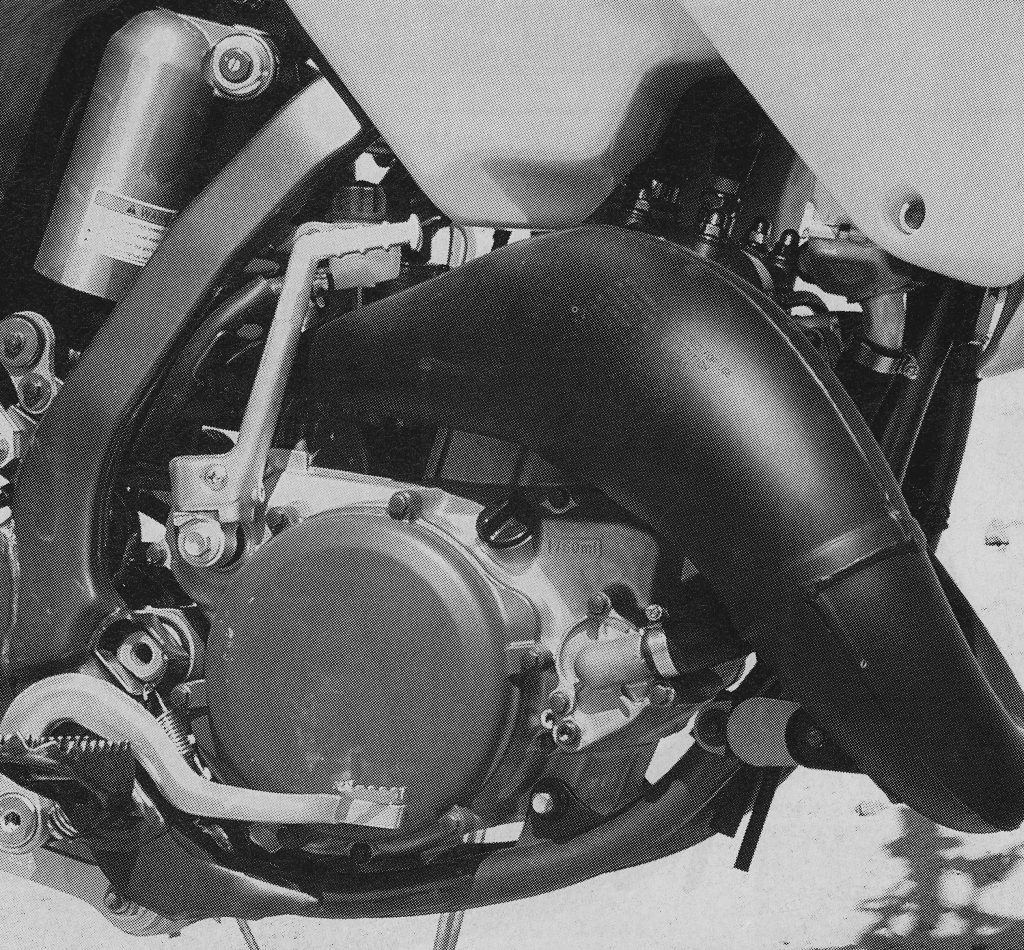 The RM’s new 124.8cc mill offered merely adequate bottom-end power, but from the mid-on up it was an all-star. Slower riders benefited from gearing it down a bit, but if you had the talent to keep it singing the RM offered a very competitive power package. Photo Credit: Dirt Bike
The RM’s new 124.8cc mill offered merely adequate bottom-end power, but from the mid-on up it was an all-star. Slower riders benefited from gearing it down a bit, but if you had the talent to keep it singing the RM offered a very competitive power package. Photo Credit: Dirt Bike
Internally, the new motor featured a 54 x 54.5mm bore and stroke for 124.8cc of overall displacement. All-new porting was added to the cylinder and the power valve system was massaged to boost top-end performance. The ignition and crank were also modified to be lighter and more responsive. On the transmission side, lower first and second gears were installed to get the bike off the line and out of turns easier. The ratios for third through sixth remained unchanged. Because some riders had complained about the engagements of the clutch the previous few years, Suzuki redesigned the clutch actuator for ’01 to provide more positive engagement. Lastly, a new exhaust was bolted on to match the new porting profile. To save some additional weight, the stampings on the pipe were thinner for 2001 and the exhaust hangers were changed from steel to aluminum. All told, the trimming and tucking program added up to an impressive four-pound reduction in weight over the year before.
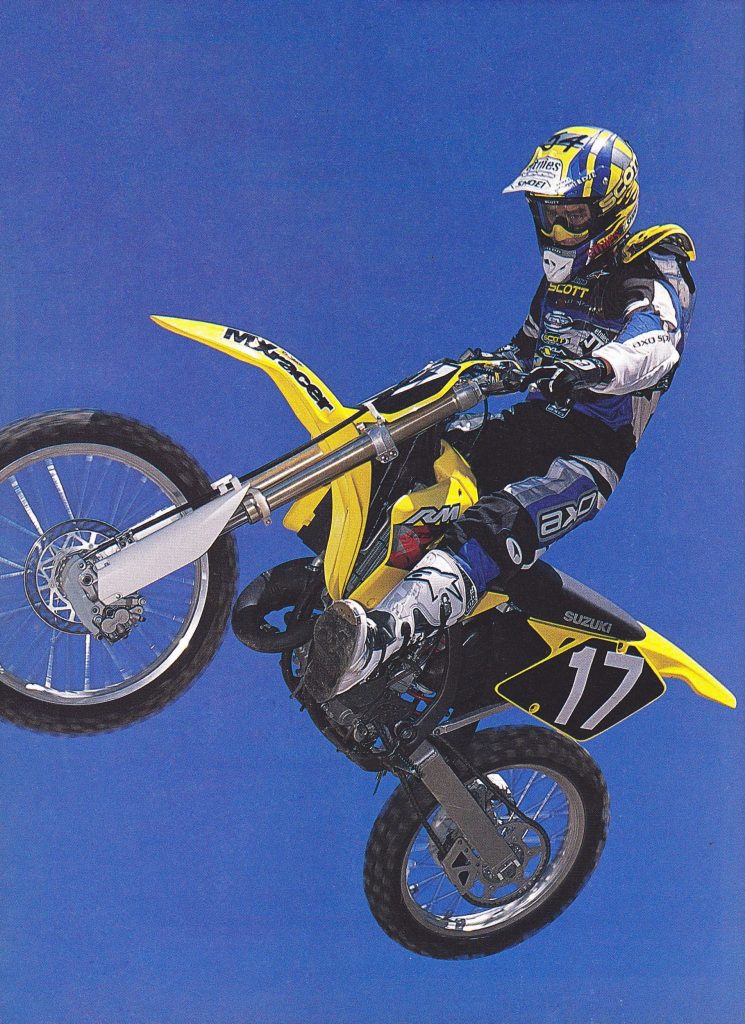 With strong power and an ultra-light feel the RM125 was one of the best leapers in the class in 2001. Here Suzuki’s rising star Shane Bess demonstrates. Photo Credit: Corey Neuer
With strong power and an ultra-light feel the RM125 was one of the best leapers in the class in 2001. Here Suzuki’s rising star Shane Bess demonstrates. Photo Credit: Corey Neuer
On the track, the new RM125 ran similarly to the 2000, but with more power at every point on the curve. Like the year before, it was not a tractor, but it did pull decently well down low for a high-strung racing 125. Thankfully, all it took was a quick stab of the clutch to get the new motor up and in the meat of its powerband. Once on the pipe, the yellow zonker pulled strongly through the midrange and into an ear-splitting top-end hook. It was not as outright fast as the KTM 125 on top, but it was far better than the narrowly-powered KX and CR. For absolute novices, the slightly more forgiving YZ125 powerband might have been better, but for anyone above the beginner class, the RM was an excellent choice.
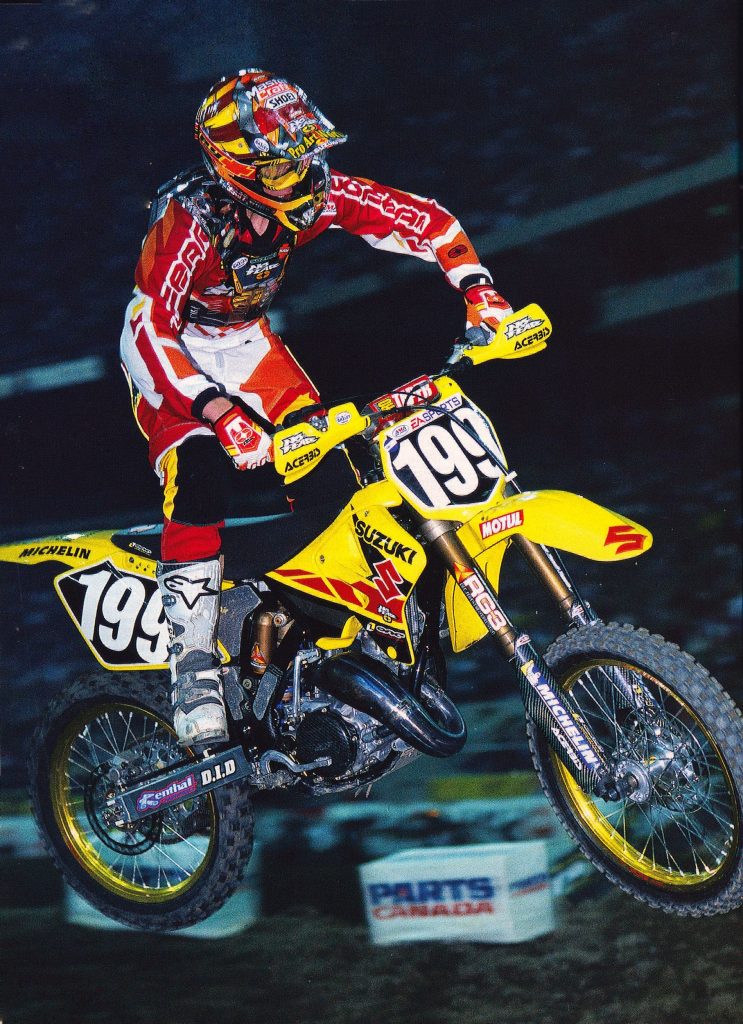 Suzuki superstar Travis Pastrana piloted the all-new RM125 to his first and only 125 Supercross title in 2001. Photo Credit: Kinney Jones
Suzuki superstar Travis Pastrana piloted the all-new RM125 to his first and only 125 Supercross title in 2001. Photo Credit: Kinney Jones
In the handling department, the new frame, layout, and suspension made the RM one of the best-handling packages available in 2001. The new bodywork looked great, was super slim, and made it easy to move around in the air and on the ground. Pretty much everyone below Travis Pastrana’s six-foot-plus frame found the new layout to be comfortable and roomy. On the track, the new bright yellow RM continued Suzuki’s tradition of favoring turning prowess over high-speed precision. In the twisties, the ’01 RM125 had no peers. It was the king of the inside line and could carve circles around most of its rivals. Unlike many machines, the RM did not care if you were out of position or late on the throttle, just saw at the bars and the RM was happy to change direction. At speed, this nimbleness manifested itself as a rather disconcerting wander that made the bike feel less planted than bikes like the KX125. This trait was less apparent than in previous RMs, but not completely exorcised. On a high-speed track the RM was capable, but not confidence-inspiring; tighten things up though, and the RM came into its own.
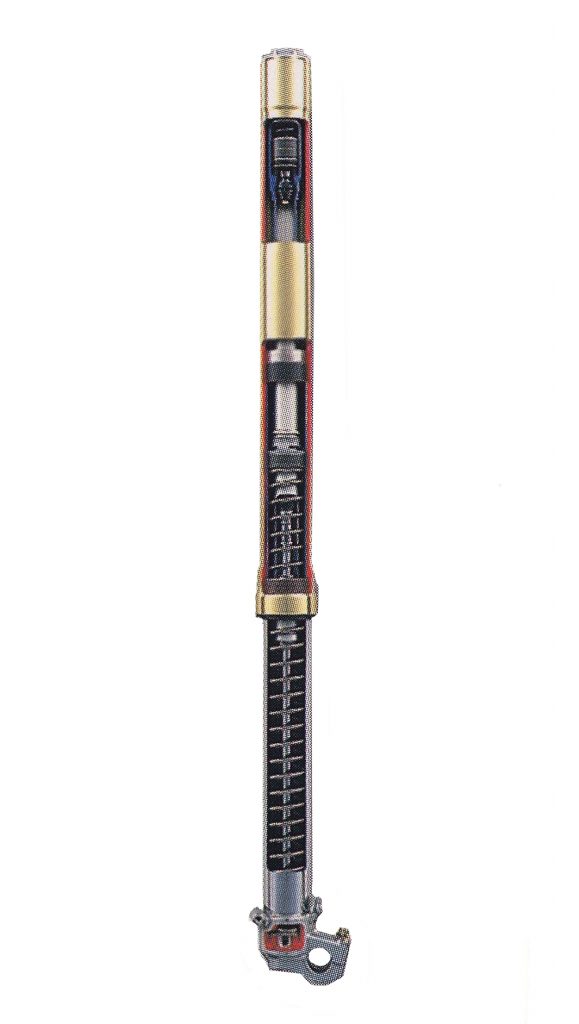 An all-new fork for 2001 offered a smaller outer diameter, lower weight, and revised internals. Photo Credit: Suzuki.
An all-new fork for 2001 offered a smaller outer diameter, lower weight, and revised internals. Photo Credit: Suzuki.
 An all-new shock for 2001 added high and low-speed compression damping for increased adjustability. Photo Credit: Motocross Action.
An all-new shock for 2001 added high and low-speed compression damping for increased adjustability. Photo Credit: Motocross Action.
On the suspension end of things, Suzuki chose Showa as the provider for their new RM125. This was in contrast to the equally new RM250 which employed Kayaba components for its suspension duties. To work best with the all-new chassis, Suzuki’s engineers spec’d a redesigned version of Showa’s Twin-Chamber inverted cartridge forks for the new machine. These new 47mm forks were 2mm smaller than in 2000 and featured a revised damping system for improved rider comfort. The new forks repositioned the springs to the bottom of the tubes for better weight distribution and added a separator to smooth operation by reducing air volume at full compression. They also added a low-speed compression valve and spec’d a slightly lighter spring for 2001.
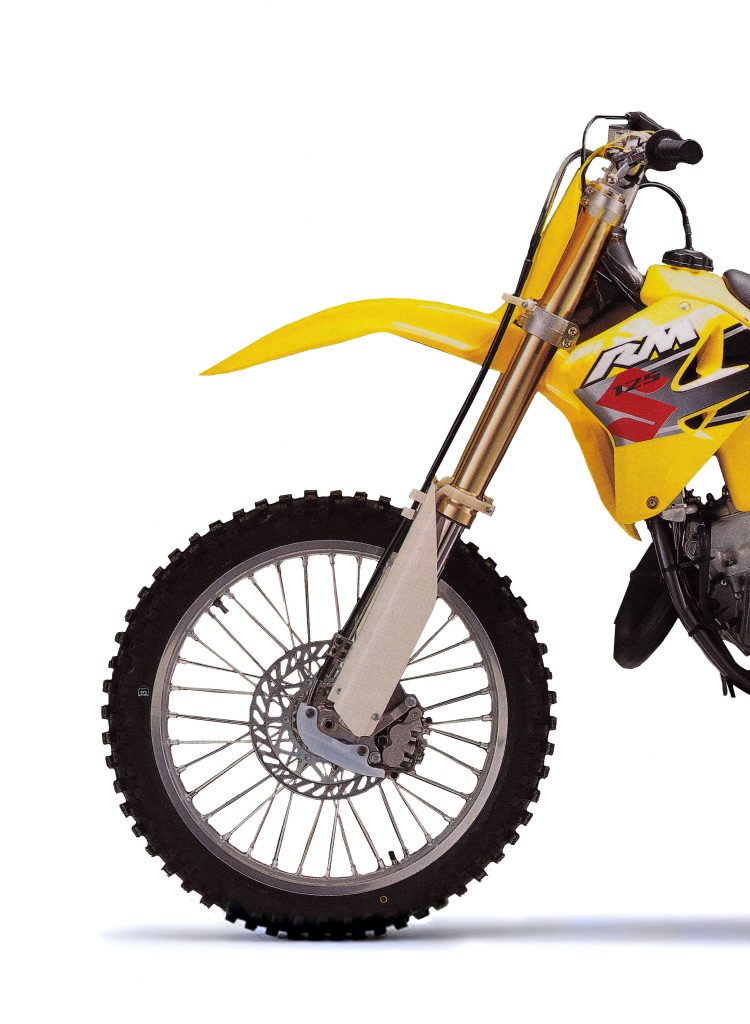 The RM’s new 47mm Showa Twin-Chamber cartridge forks offered a smooth and well-controlled ride that was praised by all testers. Heavier or really fast guys might have wanted stiffer springs but for most riders in the RM’s target demo, they were spot on. Photo Credit: Suzuki
The RM’s new 47mm Showa Twin-Chamber cartridge forks offered a smooth and well-controlled ride that was praised by all testers. Heavier or really fast guys might have wanted stiffer springs but for most riders in the RM’s target demo, they were spot on. Photo Credit: Suzuki
On the shock side, Showa was once again used as the provider and Suzuki made several changes aimed at saving weight and improving performance. First up was an all-new damping system that added separate controls for high and low-speed compression damping. The top shock mount was changed to a needle bearing for smoother action and the entire linkage was redesigned. The new linkage was lighter overall and featured a revised rising rate for better response over small ripples and braking bumps. The 50mm shock body was all-new as well and matched with a lighter (in actual weight, not spring rate) spring.
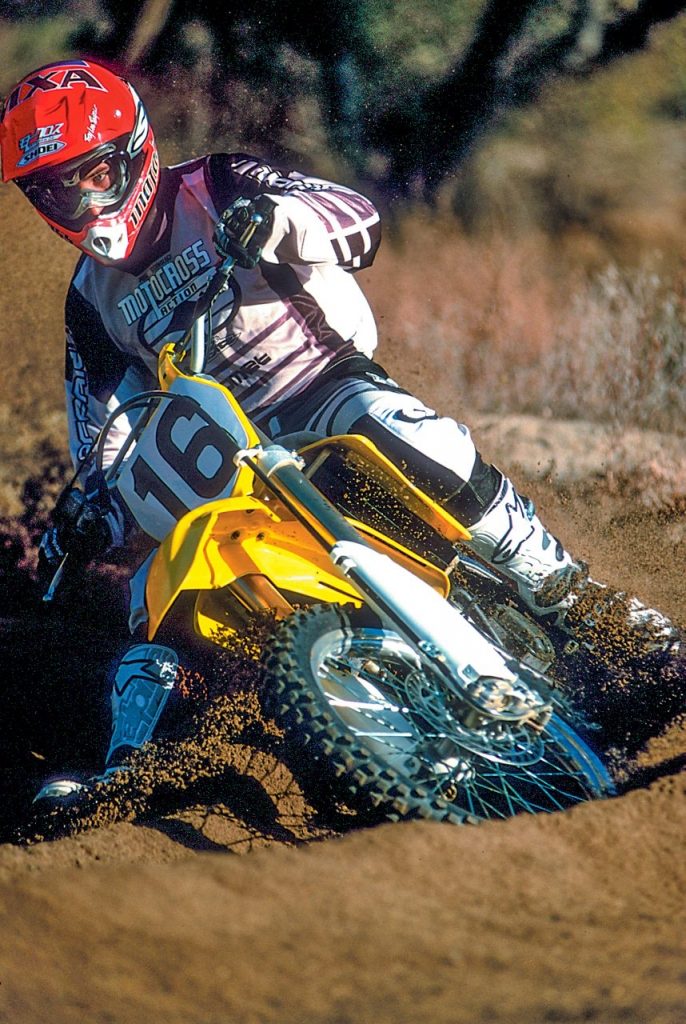 Turning continued to be the RM’s claim to fame in 2001. The new machine was even more precise in the turns and a tiny bit less schizophrenic at speed. Photo Credit: Motocross Action
Turning continued to be the RM’s claim to fame in 2001. The new machine was even more precise in the turns and a tiny bit less schizophrenic at speed. Photo Credit: Motocross Action
In terms of performance, the new RM125 offered one of the most well-regarded suspension packages of 2001. The forks were plush, well-damped, and excellent for anyone below the pro class. If you were heavier than the average 125 pilot or a fan of Pastrana-style mega-leaps a switch to stiffer springs was probably advisable, but for most riders in the RM125’s target market they were excellent.
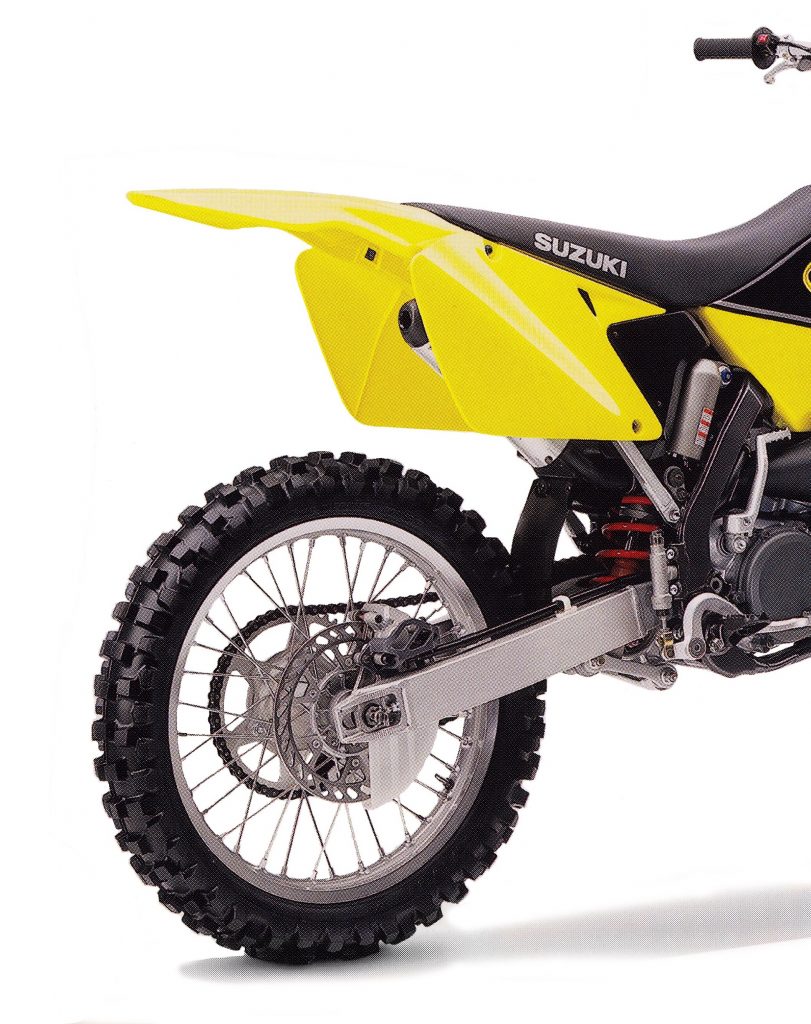 The new shock on the RM proved just as popular with testers as the forks. It was plush on the small chop and well-controlled on major G-outs. As long as your name was not Pastrana it was likely to be right in the ballpark. Photo Credit: Suzuki
The new shock on the RM proved just as popular with testers as the forks. It was plush on the small chop and well-controlled on major G-outs. As long as your name was not Pastrana it was likely to be right in the ballpark. Photo Credit: Suzuki
On the shock side, the RM’s Showa damper was as well-liked as the excellent forks. It was exceedingly plush on braking bumps and well-controlled on hard hits. Like the forks, the shock could be a little soft for really fast guys but most riders below the pro class loved its performance. With the new low and high-speed compression circuits added to the rebound adjustability, there was an almost infinite amount of setting combinations available. While this raised the likelihood of getting lost down a settings rabbit hole, it also made the bike capable of better handling a wide variety of rider sizes and skill levels. For most riders, only a few clicks were required to get excellent performance out of the RM’s shock in 2001.
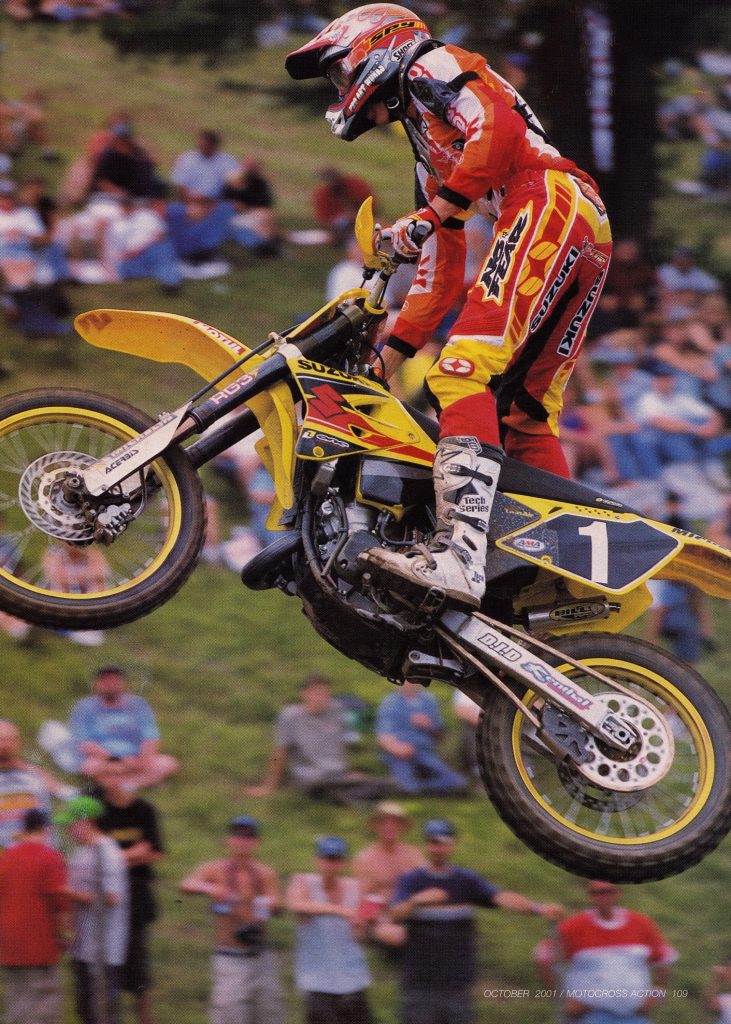 Half-way through the 2001 125 outdoor season Travis Pastrana looked like a solid bet to repeat as 125 National Motocross champ. That is, until a crash while leading at Unadilla left Pastrana with a DNF and a severe concussion. Travis would try to battle back two weeks later at Washougal in an effort to keep his title hopes alive but another crash in moto two would leave him once again dazed and out of title contention. Photo Credit: Motocross Action
Half-way through the 2001 125 outdoor season Travis Pastrana looked like a solid bet to repeat as 125 National Motocross champ. That is, until a crash while leading at Unadilla left Pastrana with a DNF and a severe concussion. Travis would try to battle back two weeks later at Washougal in an effort to keep his title hopes alive but another crash in moto two would leave him once again dazed and out of title contention. Photo Credit: Motocross Action
On the detailing side, the RM was better thought out than previous Suzukis but still a tick behind the best bikes in the class in some categories. The redesigned bodywork was well-liked for its appearance and fitment, but the new thinner plastic was flimsy and not particularly durable. The stock graphics were even worse and destined to be shredded within a few rides. The new clutch offered a super-light pull and smooth action, but not much in the way of durability. Even a moderate amount of clutch abuse (a requirement on any 125) left it slipping and begging for an aftermarket upgrade. Overall reliability was improved over previous Suzuki 125s, but it remained the quickest to wear out and the fastest to feel ratty if unattended. Things like the wimpy stock chain, butter-soft sprockets, and chintzy steel bars made the RM seem cheap compared to bikes like the KTM125.
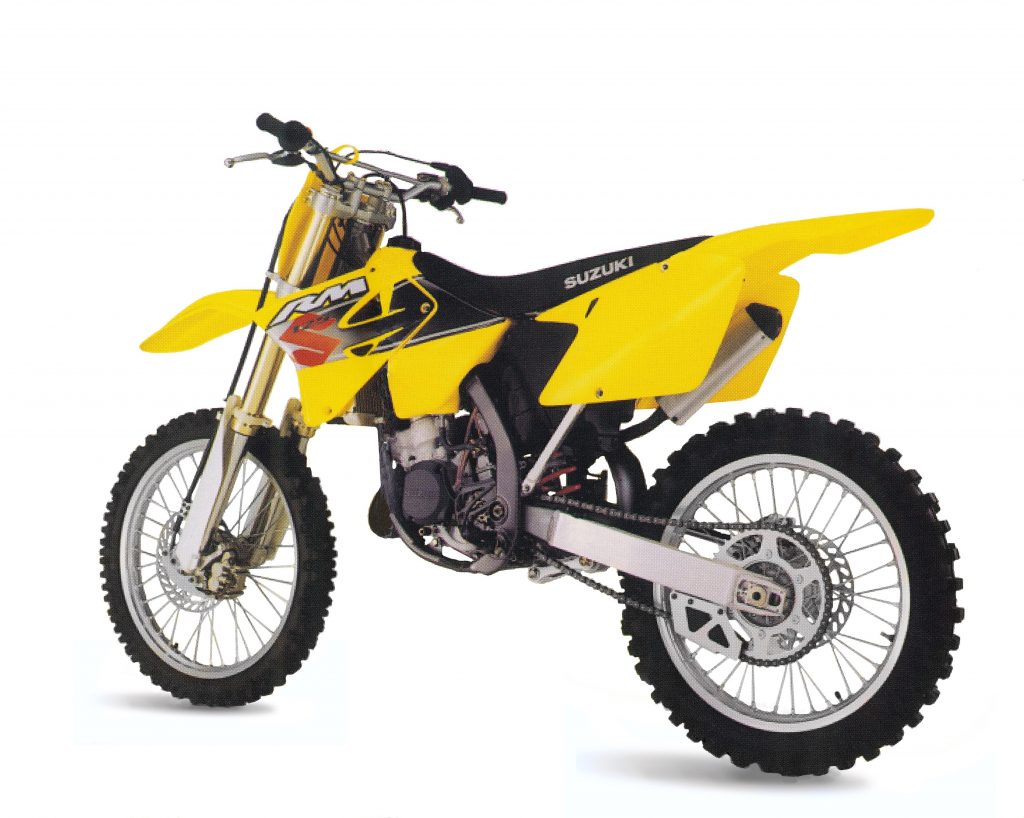 In 2001, the all-new RM125 offered sexy bodywork, supple suspension, and a motor that didn’t stop pulling until dogs started to howl. As long as you could keep it singing, it was hard to beat Suzuki’s bright yellow screamer. Photo Credit: Suzuki
In 2001, the all-new RM125 offered sexy bodywork, supple suspension, and a motor that didn’t stop pulling until dogs started to howl. As long as you could keep it singing, it was hard to beat Suzuki’s bright yellow screamer. Photo Credit: Suzuki
On the positive side of the equation were the RM’s excellent ergonomics, sexy looks, supple suspension, powerful motor, sharp handling, and strong brakes. In 2001, Suzuki provided an excellent basis from which to build a title-winning package. Out of the box, it was fast, well suspended, and competitive with anything else in its class. It was not as outright powerful as the KTM or as stone-axe reliable as the Honda, but it was a far better overall machine than either one. In 2001, Suzuki nailed the elusive combination of usability, performance, and fun with their new RM125. Light, flickable, and begging to be pinned to the stops, the 2001 Suzuki RM125 was everything a great 125 should be.
For your daily dose of old school moto goodness, make sure to follow me on Instagram and Twitter @tonyblazier
For questions or comments, feel free to drop me a line anytime at TheMotocrossVault@Gmail.com


